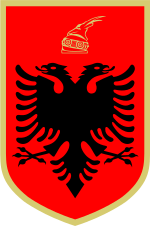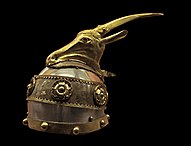Emblem of the Republic of Albania
The Emblem of the Republic of Albania (Albanian: Stema e Republikës së Shqipërisë) is an adaptation of the flag of Albania. It is based on the flag and seal of Gjergj Kastrioti Skanderbeg. The crest above the head of the two-headed eagle is the helmet of Skanderbeg, surmounted with billy goat's horns. The eagle is considered to violate the conventional rule of tincture, which forbids placing a colour (i.e. a dark tincture) upon another colour.[1]
| Emblem of the Republic of Albania | |
|---|---|
 | |
| Armiger | Republic of Albania |
| Adopted | 21 October 1998 |
| Crest | Helmet of Skanderbeg |
| Blazon | A red shield surrounded by a gold stripe with a black two-headed eagle placed in the center and on top, a helmet in the shape of a goat's head in gold. |
Official description
The emblem is described in Article 14 of the Constitution of Albania:
"The Emblem of the Republic of Albania represents a shield with a red field and a black double-headed eagle in the center. At the top of the shield, in golden color, is placed the helmet of Skanderbeg."[2]
The design is further specified in Article 7 of the Law 8926: "The Emblem of the Republic of Albania is a state symbol. It displays a shield, colored blood red, with an eagle in the center, the same as the eagle of the national flag of the Republic of Albania. On top of the shield, in gold color, is Gjergj Kastioti's helm, shown in right profile. The shield's dimensions have a 1:1.5 ratio."
The same law specifies that the eagle on the flag has its wings open to the sides, nine feathers on each, and seven on the tail.[3]
Significance of the helmet

Skanderbeg's helmet is made of white metal, adorned with a strip dressed in gold. On its top lies the head of a horned goat made of bronze, also dressed in gold. The bottom part bears a copper strip adorned with a monogram separated by rosettes: * IN * PE * RA * TO * RE * BT *, standing for Iesus Nazarenus * Principi Emathie * Regi Albaniae * Terrori Osmanorum * Regi Epirotarum * Benedictat Te (Jesus the Nazarene Blesses Thee, Prince of Mat, King of Albania, Terror of the Ottomans, King of Epirus).
The inscriptions on the helmet may refer to the unsettled name by which Albania was known at the time, as a means to identify Skanderbeg's leadership over all Albanians across regional denominative identifications. Contemporary sources show that 14th century Albanians were invariably identified as a tribal peoples, with no state of their own. Thus, depending on where they lived – North or South, in the plains or in the mountains, and to which civilization they subscribed to - we have Turkish Arnauts, Greek Arbanites or Albanoi, Albanian Arber, Arben, Arberesh, Epirotas.[4]
According to a report by historian Shefqet Pllana, Sami Frashëri in his Kamus-al-Alam maintains that the wording "Dhu lKarnejn" (owner of the two horns) was an appellative attributed to Alexander the Great of Macedon, the very name which Skanderbeg bore in the Islamic form. This second explanation may not be the truer, since the theory of the Macedonian-Albanian and Epirot-Albanian continuance is strong among Albanians but not among all the peoples of Europe. This opinion agrees with the work of Marin Barleti who writes: "When the people saw all those young and brave men around Skanderbeg, then it was not hard to believe that the armies of Murad II were so defeated by the Albanians. Indeed, the times when the star of Macedon shone brilliantly had returned, just as they seemed in those long forgotten times of Pyrrhus and Alexander."
Historical emblems
| Achievement of the Prince of Albania (1914) |
|---|
| The achievement consists of a black two-headed eagle with a golden beak, claws and a red tongue. The claws have four pointed thunderbolts. The center of the breast has a shield placed with a peacock displaying its pride on a gold background within a black and red bordure compony, all wrapped under a purple mantle, lined ermine and with golden fringes, falling from the Albanian princely crown. A blue ribbon with the motto 'FIDELITATE ET VERITATE' (True and Truth) in golden lettering hovers on the upper part of the mantle. Designed by Emil Doepler. Adopted on April 10, 1914. |
| Arms of State of the Kingdom of Albania (1928–1939) |
| The Arms of State depicts an all black two-headed eagle on a red background. The Helm of Skanderbeg is in silver with light-effects, the lower seam and encircling band have a gold color with golden ornaments. The lower part is wrapped in a purple mantle. Redesigned from its original state by Hyacinthe de Keranrouë with slight aesthetic changes. Adopted on August 8, 1929. |
| Greater Arms of State (1939–1943) |
| The Greater Arms of State consists of a red shield with a black two-headed eagle crowned with the Helmet of Skanderbeg. Supporters: two adjoining fasces, their axes pointing outwards, bound with leather straps, connected above with the Savoye-knot and below with a blue ribbon three times inscribed with the motto FERT. The mantle around the whole is purple, with golden fringes and tassels and crested with the royal crown. Adopted on September 28, 1939. |
| State Emblem of the People's Republic of Albania (1946–1991) |
 |
References
- Hubert-Herald.nl
- Kushtetuta e Republikës së Shqipërisë
- Ligj Nr. 8926
- Schmitt, Oliver Jens . "Arbëria Venedike (1392-1479)" [Das Venezianische Albanien (1392–1479)]. Tiranë: K&B, 2007. 63–85.
External links
| Wikimedia Commons has media related to National Emblem of Albania. |